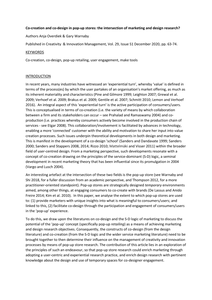Co-creation as a concept and process has been prominent in both marketing and design research over the past ten years. Referring respectively to the active collaboration of firms with their stakeholders in value creation, or to the participation of design users in the design research process, there has arguably been little common discourse between these academic disciplines. This article seeks to redress this deficiency by connecting marketing and design research together—and particularly the concepts of co-creation and co-design—to advance theory and broaden the scope of applied research into the topic. It does this by elaborating the notion of the pop-up store as temporary place of consumer/user engagement, to build common ground for theory and experimentation in terms of allowing marketers insight into what is meaningful to consumers and in terms of facilitating co-design. The article describes two case studies, which outline how this can occur and concludes by proposing principles and an agenda for future marketing/design pop-up research. This is the peer reviewed version of the following article: Overdiek A. & Warnaby G. (2020), "Co-creation and co-design in pop-up stores: the intersection of marketing and design research?", Creativity & Innovation Management, Vol. 29, Issue S1, pp. 63-74, which has been published in final form at https://doi.org/10.1111/caim.12373. This article may be used for non-commercial purposes in accordance with Wiley Terms and Conditions for Use of Self-Archived Versions. LinkedIn: https://nl.linkedin.com/in/overdiek12345
MULTIFILE

What is a pop-up store and how can it be used for organisational counterspacing? The pop-up can be interpreted as a fashionable and hypermodern platform focusing on the needs of a younger generation of consumers that searches for new experiences and is prone to ad hoc decision-making. From this perspective, the pop-up is a typical expression of the experience economy. But it is more. The ephemeral pop-up store, usually lasting from one day to six months, is also a spatial practice on the boundary between place as something stable/univocal and space as something transitory/polyphonic. Organizational theory has criticized the idea of a stable place and proposed the concept of spacing with a focus on the becoming of space. In this article, the pop-up store is introduced as a fashionable intervention into organizational spacing. It suggests a complementary perspective to non-representational theory and frames the pop-up as co-actor engaging everyday users in appropriating space. Drawing on Lefebvre’s notions of differential space, festival and evental moment, theory is revisited and then operationalized in two pop-up store experiments. Apart from contributing to the ongoing theoretical exploration of the spacing concept, this article aims to inspire differential pop-up practices in organisations. https://www.linkedin.com/in/overdiek12345/
DOCUMENT

A 4*4 PitStop is a metaphor for the work method or format used for a pop-up professional network. The method is designed to allow work, innovation and learning to go hand in hand. This format is based on the goals and direction provided by the participating professionals themselves. With this guide, we are sharing the results with professionals who want to start their own 4*4 PitStop.
DOCUMENT
